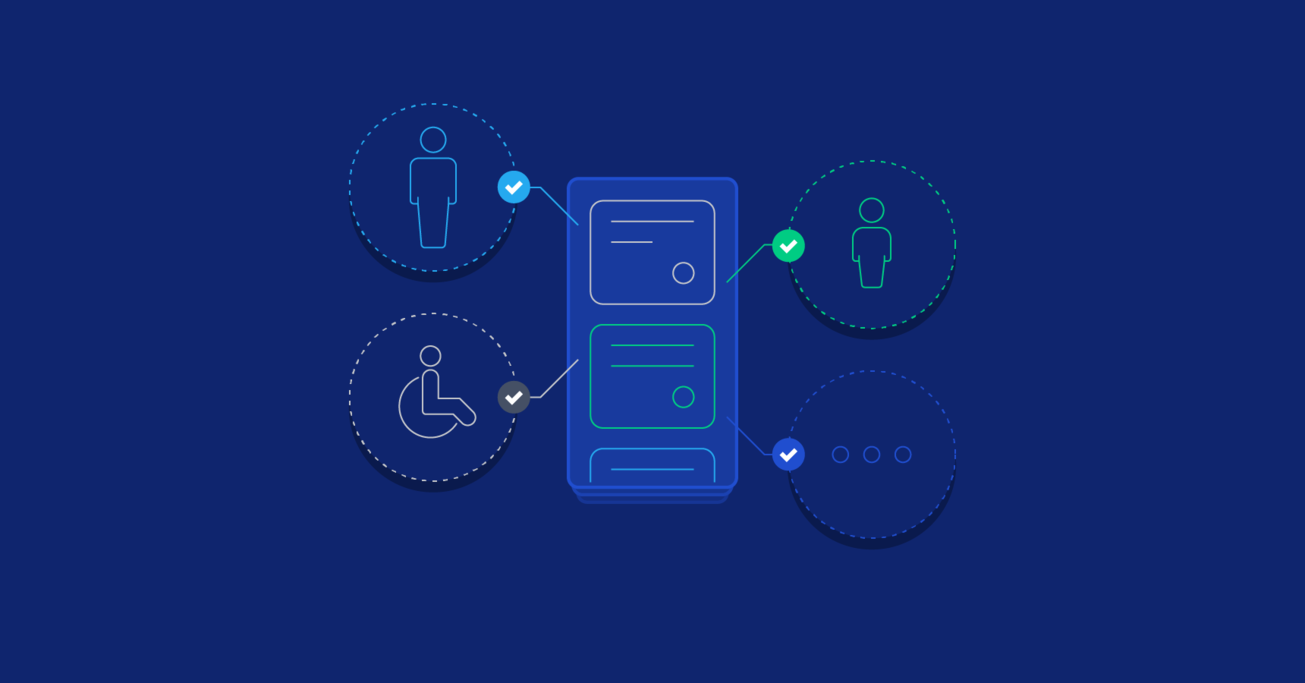All Together Now: An Overview of Inclusive Design
Using the inclusive design process helps designers consider a broad cross-section of human perspectives, abilities, and backgrounds to create products that make everyone feel included.
Using the inclusive design process helps designers consider a broad cross-section of human perspectives, abilities, and backgrounds to create products that make everyone feel included.
Fanni is a designer with a master’s degree in cognitive neuroscience. She designs products that focus on both user and business goals.
PREVIOUSLY AT

When thinking about making a website design available to all, accessibility is usually the first thing that comes to mind. But accessibility is an attribute of the final product. Inclusive design, on the other hand, focuses on the process of making a design user-friendly to the broadest range of people.
Where accessibility focuses on making a design friendly to people with at least somewhat specific physical or cognitive limitations or differences, inclusive design is much broader than that.
Susan Goltsman accurately sums up the definition of inclusive design:
Inclusive design doesn’t mean you’re designing one thing for all people. You’re designing a diversity of ways to participate so that everyone has a sense of belonging.
Instead of looking at a single solution to a design problem, inclusive design asks UX designers to look at all the ways someone can participate in the primary function of a website or a digital product. For example, if the primary purpose of a website is to educate visitors about the best types of coffee in the world, the site could include written material, infographics, interactive content, videos, and audio content. These types of content cover the broadest range of ways for people to participate, and many will take advantage of multiple methods.
Why Inclusive Design Is Necessary
The point of inclusive design is to support the full range of human diversity. While accessibility focuses on accommodating differing abilities between people, inclusive design incorporates differing perspectives—including those of people with disabilities—into the process of design.
People who use digital products come from a wide variety of backgrounds and have diverse life experiences. These experiences impact the way they interact with the world, including the way they interact with websites and apps.
Inclusive design aims to accommodate those diverse experiences, both in the final product and in the design process itself. Inclusive design involves a broad group of people in the actual design process—both in the design team and user testing. The result of the inclusive design process is a universal design that the maximum number of people can use.

Most People Have a “Disability”
There are many “disabilities” that people tend to overlook. According to the Vision Council of America, more than 76% of American adults used some form of vision correction as of 2015. That’s merely one example of a physical impairment that designers can account for in their work.
Another commonly overlooked accessibility issue is the cognitive and physical changes people undergo as they age. Studies show that as people age, they process information differently than when they’re younger. There are differences in memory, concentration, and even things like what motivates them to use technology and various websites.
Between 2018 and 2060, the population of adults over the age of 65 in the United States will nearly double, from 52 million to 95 million (rising from 16% of the population to 23%). Similar trends are happening in countries throughout the world. And as people who grew up with technology age, the differences in how they interact with websites, apps, and other digital products will be harder to predict.

Vision loss can be compensated for with larger font sizes and increasing contrast, or a feature to easily adjust font sizes up or down according to the user’s preferences and needs. The same goes for icons and other visual elements.
Cognitive impairments that often come with age can slow older people down. It’s not that they can’t complete the same tasks as younger people; it just takes them longer. They can also have a harder time remembering information they learned earlier. Adding a more thorough onboarding, well-written documentation, and even things like app notifications can compensate for these issues.
Inclusive design takes all of the above into account by incorporating people from those demographics. It’s not about guessing what visitors to a website will want; it’s about finding out directly from them what they want and need.
The inclusive design process benefits all users, regardless of whether they have a disability or impairment. For example, a website might offer transcripts for video or audio content to better serve people who are hard of hearing. These transcripts can come in handy at other times too, such as when a person forgets their headphones and can’t listen to audio content in a library or some other public place.
Compensations made for age can also benefit younger people. For example, larger text sizes can be easier to read for people who deal with eye strain or those who do a lot of reading throughout their day. The less work people have to do to consume the content on a site, the more enjoyable they’ll find the experience.
The point of inclusive design is to make a website work well for as many people as possible. Accessibility is a component of that, as are universal design principles. However, empathy with the wide variety of people who might use that website is the most crucial element to inclusive UX.

Inclusive Design Takes Accessibility a Step Further
Accessibility is about people with disabilities being able to use a design. Inclusive design takes the process a step further to ensure the website or app in question serves everyone who visits that website. Inclusive design is a mindset. Accessibility is one outcome of that mindset.
People around the world visit websites for a variety of reasons: for information, to shop, and to be entertained. Those people come from a variety of backgrounds and can’t always interact with a site in the same ways. What happens when someone visits a website for information but has limited literacy skills? If audio or video content is available, they can access information that would be off-limits if it were purely text-based.
The inclusive design process aims to create websites that are welcoming to all. It’s common sense to think about that process in terms of including different groups, but it pays for designers also to consider what groups are typically excluded.
When approaching a new design project, designers should think about the groups that typically haven’t had easy access to existing products. The example with limited literacy skills mentioned above is one such situation. But what other groups may be excluded?
Consider socioeconomic factors. Information or situations that a middle-class person from North America or Europe might be familiar with as part of their daily lives might be entirely foreign to a poor person in Southeast Asia, for example. The opposite is also true.

How to Create Inclusive Designs
Creating inclusive designs is a fairly straightforward process. The first step is setting up a team with a variety of perspectives. While it’s unlikely a design team will include the perspectives of every potential visitor to a website, the more diverse the team, the more comprehensive the results will be.
When talking about diverse design teams, there are several factors to consider: people from different socioeconomic backgrounds, people from different cultures, people with differing abilities, people of different genders, people from different parts of the country (and world), and different ages.
When a team can incorporate different perspectives from the outset, the designs they create will be leagues ahead of designers that come from a design team that all share similar backgrounds and abilities.
However, a diverse team only goes so far. After the first iterations of a design are created, designers need to incorporate user testing with a heterogeneous group of people. Look for people who represent the broadest range of potential end users of a product.

Accessibility guidelines can go a long way toward making sites more universally friendly, but UX designers can take those guidelines a step further by considering the motivations behind them. What issues do the guidelines aim to solve? What can a design team do to go above and beyond the guidelines to address those issues?
Accessibility guidelines sometimes serve more like a band-aid than a real solution. Real solutions exist in removing barriers altogether, rather than just giving people tools to adapt to them. Every website and digital product will likely need to approach these solutions differently, but thinking about them critically will help the inclusive design process.
Microsoft has proposed inclusive design principles that are worth studying and incorporating. They focus on recognizing exclusion as the first step toward inclusive UX. They encourage designers to learn from diversity.
But the most interesting and useful takeaway from Microsoft’s inclusive design principles is the idea of solving for one but extending to many. This idea proposes that the constraints of designing for people with disabilities benefits all users in the end. All people share common experiences—they all have motivations and build relationships—and those commonalities can serve as the foundation for creating universally beneficial designs.
Take an example from Microsoft’s Inclusive Design Toolkit. A product might be designed for a person who only has one hand (a permanent disability), for example. The obvious extension of that would be that the same design could be helpful to anyone who has a temporary hand injury. And there are extensions beyond that. A new parent who often has their newborn in one arm and only uses one hand for most interactions could also benefit. There are multiple use cases where an interface that only requires one hand to use is useful beyond only helping the person it was adapted for initially.
“Designing with constraints in mind is simply designing well.” – Microsoft’s Inclusive Design Toolkit

Conclusion
Good design aims to create a great user experience for everyone who touches it. Inclusive design is one of the most comprehensive pathways to achieve that end.
By using the inclusive design process to consider a broad cross-section of perspectives, abilities, and backgrounds, designers can create products that work well for all people, rather than just those people represented on the design team. The products created from this process will not only serve those with disabilities but also create better experiences for everyone.
Rather than creating adaptations for barriers that might exist within a product, UX designers can create better designs by removing as many barriers as they can. The result will be products that are more inclusive, work better, create more engaging user experiences, and also satisfy accessibility requirements.
Further Reading on the Toptal Blog:
- Age Before Beauty – A Guide to Interface Design for Older Adults
- UX and the Importance of Web Accessibility
- Design Psychology and the Neuroscience of Awesome UX
- Designing for Readability: A Guide to Web Typography (With Infographic)
- Are All Trends Worth It? The Top 5 Most Common UX Mistakes Web Designers Make
Understanding the basics
What does inclusive design mean?
Inclusive design is a process in which designers incorporate a variety of perspectives and backgrounds to create a design that’s welcoming to everyone. Including diverse perspectives on the design team and in user testing groups is an important part of this process, as are accessibility guidelines.
What is the difference between inclusive design and universal design?
Inclusive design is a process that takes diverse human perspectives and experiences into account during the creation of a product to make it friendly to all. Universal design, on the other hand, is more about creating an outcome that is universally appealing than the process itself.
Why is inclusive design important?
Inclusive design takes the idea of accessibility a step further, making websites and other digital products welcoming to all. Inclusive design expands the audience for a digital product by including the diversity of ways people interact with that product and creating an optimal user experience.
What are the seven universal design principles?
The seven principles of universal design are equitable use, flexibility in use, simple and intuitive use, perceptible information, error tolerance, low physical effort, size/space for approach and use. It originates in the physical world but these inclusive design principles can also be applied to digital design.
About the author
Fanni is a designer with a master’s degree in cognitive neuroscience. She designs products that focus on both user and business goals.
PREVIOUSLY AT


